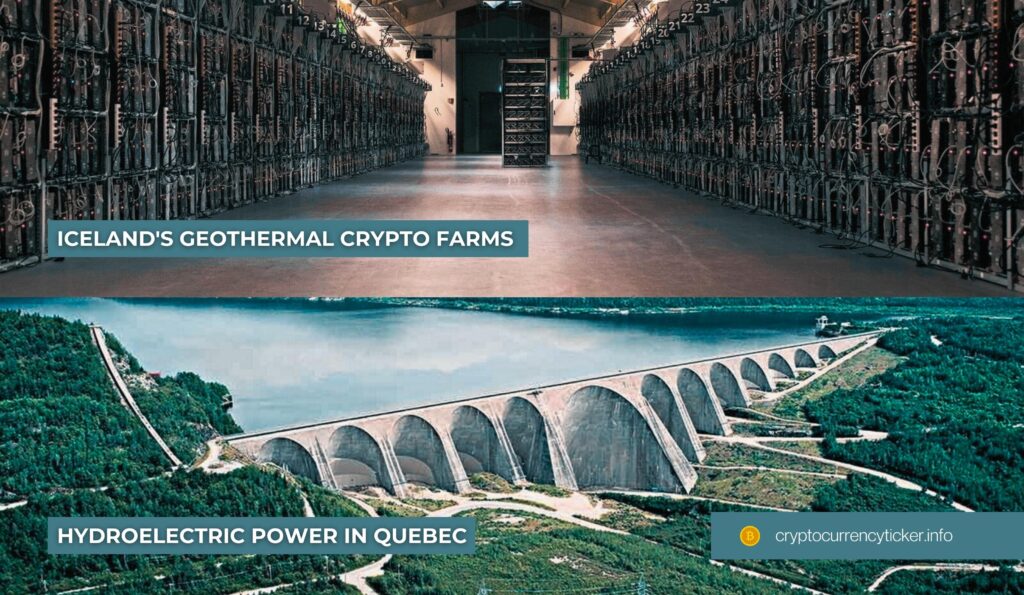In recent years, cryptocurrencies like Bitcoin have surged in popularity, heralded as the future of finance. This digital revolution gained momentum with significant investments from major players like Tesla and a spike in day trading during the pandemic. However, beneath the virtual façade of these digital currencies lies a significant environmental cost, often overlooked: their energy consumption.
Cryptocurrency transactions, contrary to popular belief, are not devoid of environmental impact. The process of creating these digital currencies, known as cryptomining, is extremely energy-intensive. This article aims to shed light on the hidden environmental costs of cryptocurrency mining, delving into its substantial energy demands and the resultant carbon footprint.
As we explore the world of cryptocurrencies, it’s crucial to understand the balance between their innovative potential and the ecological challenges they present. This discussion is not just about the financial implications of digital currencies but also about their long-term sustainability in a world grappling with climate change and resource depletion.
Understanding the environmental impact of crypto mining is essential for making informed decisions about the future of these digital assets. This article will provide a comprehensive overview of the challenges posed by cryptomining and the innovative solutions being developed to make it more sustainable.
Cryptocurrency Mining: Digging Into the Digital Earth
At the heart of the cryptocurrency ecosystem lies cryptomining, an intricate process that serves a dual purpose: it allows for the creation of new coins and maintains the ledger of transactions upon which cryptocurrency operates. This ledger, known as the blockchain, is a decentralized network of data, fortified against fraud by the complexity of mathematical algorithms that miners must solve.
In essence, cryptomining involves powerful computers competing to solve these mathematical puzzles. The first to arrive at the solution validates the transaction block and, as a reward, receives cryptocurrency tokens. This incentivizes miners to deploy massive computing resources in the race to solve the puzzles first.
The environmental implications stem from the sheer computational power required. These mining operations often consist of warehouses filled with specialized hardware that runs 24/7, consuming vast amounts of electricity. This demand for power is reflected in the following data:
- Cryptomining’s electricity costs can constitute around 60 to 70 percent of total expenses.
- Bitcoin mining alone consumes 0.40% of the world’s electricity, more than entire countries like Denmark or New Zealand.
- The carbon footprint of Bitcoin measures at 34.76 megatons of CO2 annually, equivalent to the emissions of a small industrial country.
As Bitcoin’s value climbs, so does the computational difficulty of mining, further inflating energy use. This growing consumption is a concern for an energy sector still dominated by fossil fuels, raising urgent questions about the sustainability of cryptocurrencies and their role in our energy future.
The Energy Consumption Reality: A Deep Dive
The conversation about cryptomining’s environmental impact is incomplete without a detailed look at its energy consumption. Traditional financial transactions, like those processed by Visa or Mastercard, also consume energy, but their infrastructure and operating models differ significantly from cryptocurrency mining. Here, the energy consumption is not just a byproduct of the process; it is integral to how cryptomining functions.
The statistics are startling:
- Bitcoin’s energy consumption escalated from 9.6 terawatt-hours (TWh) in February 2017 to an astonishing 73.2 TWh by January 2020.
- To put this in perspective, the annual energy consumption of Bitcoin is comparable to a medium-sized country’s energy usage.
The environmental impact of such energy use is considerable, especially when you consider the source of this energy. While some argue that a significant portion of Bitcoin’s energy comes from renewable sources, the reality is more nuanced. A University of Cambridge study found that only 39% of the energy used in Bitcoin mining comes from renewables, with coal accounting for 38% of the miner’s power. This reliance on fossil fuels exacerbates the already concerning carbon footprint of cryptocurrency mining.
Global Warming and Carbon Footprints: The Hidden Cost

The significant energy consumption of cryptomining has a direct impact on global warming due to its substantial carbon footprint. Every kilowatt-hour of energy consumed in mining, particularly from non-renewable sources like coal, releases carbon dioxide into the atmosphere, contributing to the greenhouse effect. This environmental cost becomes even more concerning when considering the following:
- The annual carbon emissions from Bitcoin mining are estimated at 34.76 megatons, equating to the emissions of countries like Denmark or New Zealand.
- A report by Nature Climate Change suggests that Bitcoin alone could increase global temperatures by 2°C within three decades if current trends continue.
These startling statistics highlight the urgent need for the cryptocurrency sector to address its environmental impact. As the popularity and value of cryptocurrencies like Bitcoin, Ethereum, and others continue to rise, so does their potential to exacerbate climate change. This situation calls for immediate action, both in the form of innovations within the cryptomining process and in the broader energy sector’s shift towards sustainability.
Towards Sustainable Crypto Mining: Renewable Energy Initiatives

In response to the environmental challenges posed by cryptomining, a shift towards sustainable energy sources is gaining momentum. This transition is crucial, considering that renewable energy sources like hydro, wind, and solar power significantly reduce the carbon footprint of mining operations.
Notable examples include:
- Iceland’s Geothermal Crypto Farms: Iceland has become a hub for crypto mining due to its abundance of renewable geothermal energy and naturally cool climate, which reduces the need for additional cooling systems for mining rigs.
- Hydroelectric Power in Quebec: In Quebec, Canada, around 95% of electricity comes from hydroelectric sources. This abundant and relatively cheap energy source has attracted a considerable number of mining operations to the region, benefiting from the low carbon footprint of hydropower.
These examples demonstrate that with the right geographical advantages and policy incentives, cryptomining can pivot towards more sustainable practices. However, the overall environmental impact of hydropower and geothermal energy sources remains a topic of debate, highlighting the complexity of finding completely green solutions in the world of cryptomining.
Navigating the Policy Landscape: The Role of Governments and Regulations
The global disparity in electricity prices and environmental policies plays a significant role in shaping the cryptomining landscape. Miners often gravitate towards regions with cheaper electricity, which sometimes means relying on non-renewable energy sources. For instance, a significant portion of Bitcoin mining was concentrated in China, where electricity costs are lower, but the reliance on coal power is high.
To address these challenges, some countries are implementing policies to either incentivize renewable energy use or discourage environmentally harmful mining practices:
- Carbon Taxation: Countries like Sweden have implemented carbon taxes, making cryptomining less profitable in regions with high CO2 emissions. This approach encourages miners to seek renewable energy sources or more eco-friendly locations.
- Direct Taxation on Mining: Proposals for direct taxation on cryptomining activities, aimed at offsetting their environmental impact, are gaining traction. Such taxes could be used to fund renewable energy projects or other environmental initiatives.
The effectiveness of these policies varies, but they reflect a growing awareness of the need to integrate environmental considerations into the cryptocurrency sector. As we progress, the role of government regulations and international cooperation becomes increasingly critical in steering cryptomining towards a more sustainable path.
Embracing Technological Alternatives: A Shift in Mining Protocols
One of the most promising solutions to reduce the environmental impact of cryptomining lies in technological innovation, particularly in the adoption of alternative mining protocols.
- Proof of Stake (PoS): Unlike the traditional ‘proof of work’ system that requires extensive computational effort, PoS allows network participants to ‘stake’ their cryptocurrency holdings to validate transactions. This method drastically reduces energy consumption. Cryptocurrencies like Cardano and Polkadot have already adopted PoS, significantly lowering their energy footprint compared to Bitcoin.
- Reusing Waste Energy: Some initiatives are exploring the reuse of waste energy for cryptomining. For instance, in regions with excess electricity production, like Sichuan, China, miners are utilizing surplus power that would otherwise go unused. This approach not only reduces waste but also provides a more eco-friendly way to mine cryptocurrencies.
These technological advancements and innovative approaches are essential in aligning the cryptocurrency sector with global sustainability goals. As the industry evolves, the continuous exploration and implementation of such alternatives will be crucial in mitigating the environmental impact of cryptomining.
The Counterargument: Reevaluating Cryptomining’s Energy Use

Despite the concerns about energy consumption, some argue that the energy use of cryptomining needs to be put into perspective. They suggest that the energy consumption, while significant, is not inherently negative and should be weighed against the utility and innovation that cryptocurrencies bring.
- Energy Use in Perspective: Comparisons are often made with the energy used by traditional banking systems and other digital technologies, pointing out that all modern conveniences come with an energy cost.
- Transparency and Renewable Incentives: Cryptomining is noted for its transparency in energy usage. Additionally, the decreasing cost of renewable energy sources is seen as an incentive for miners to shift towards more sustainable practices.
This counterargument highlights a broader issue in the technology sector: the need for a comprehensive shift to renewable energy across all industries. As cryptocurrencies continue to evolve, their environmental impact remains a critical consideration, but it is part of a larger conversation about sustainable energy use in the digital age.
Conclusion: Balancing Innovation with Sustainability
As we delve into the complexities of cryptocurrency and its environmental implications, it becomes clear that while digital currencies offer innovative financial solutions, their sustainability cannot be overlooked. The cryptomining sector faces a significant challenge: to continue its growth while actively reducing its environmental footprint.
The future of cryptocurrencies hinges on finding this balance. Sustainable energy sources, innovative mining protocols, and supportive government policies are key to achieving a greener crypto environment. As technology continues to advance, the cryptocurrency sector has the opportunity to lead by example, showcasing how innovation can align with environmental responsibility.
In conclusion, the journey of cryptocurrencies from a niche digital asset to a mainstream financial tool must include a robust commitment to environmental sustainability. Only by addressing the ecological impacts head-on can the crypto industry ensure its long-term viability and acceptance in an increasingly environmentally-conscious world.
